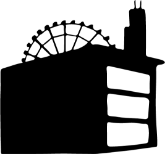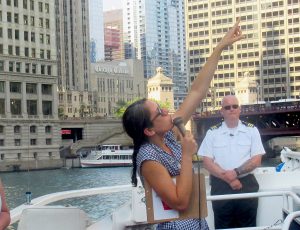DESIGN IDEAS
for the “Thank You Celebration”
DESIGN PROCESS
Read more about the thought that went into designing this experience that blended neighborhood exploration with food, learning, and community.

EVENT GOALS
Primary goal
Express gratitude to all the people who supported to Chicago Detours and helped us get to our next phase in business. Instead of offering a volume of public tours, we specialize in carefully designed custom experiences that engage people with places.
Secondary Goals
1. Offer guests the chance to experience how place-based storytelling enhances our feelings towards places. It buildings meaning into our lives. Companies are struggling to create meaning for employees and motivation to go to the workplace. Place-based storytelling is a powerful way to boost connection with the office, and needs to be part of any workplace experience strategy.
2. Demonstrate how our storytelling can enliven events in formats other than live, guided tours (i.e. printed content, video, activities led by outside experts).
3. Celebrate 12 years in business and reconnect our community.
EVENT FORMAT
Due to COVID, we wanted to make sure people would feel safe. Any large crowds culminating together would not work. We chose to design this as open house style, where people could filter through instead of being crowded all at once into a theatre, bus, or other event space.
This event format would also fulfill another guest need – since lockdown, people have gotten more used to doing things on their own schedule and their own terms. We didn’t want people to be able to feel restricted by the strict timings of a tour and a set route. The open house style of even gives guests agency in “choosing their own adventure.”
Of course people know Chicago Detours for tours, but I wanted a different kind of event. And I also wanted former employees to be able to enjoy the party, and not work it. A self-guided tour format would also contribute to some freedom and flexibility.
Initially we figured the self-guided walking tour would be on an app. However once I get into testing out the different apps,we really didn’t like the idea of people staring at their screens during a social event. In Amanda’s opinion, tour apps are incredibly effective in contained spaces like museums. However when you’re outside such as on a city sidewalk, they can disconnect you from the surroundings and even be unsafe.
In true Chicago Detours style, we decided to print the self-guided tour content and present that information with all the activities for the event. See the event program and self-guided tour content here.
CONCEPT
This is the most difficult part. In developing tours around a certain concept, I usually start with a general idea, and it isn’t until I’ve done a lot of brainstorming, discarding ideas, and a certain amount of brain-bending that I uncover the message that I truly want to share and how I want to share it.
LOCATION
I wanted to bring people to a special, historic venue. The location, of course, is a big part of what we do with Chicago Detours. And having an exceptional place is a big part of making memories.
Podhalanka has always been a favorite among the Detours staff. When I first stepped into it years ago – it almost brought me to tears as it smelled like my Polish grandmother’s house.
SELF-GUIDED TOUR RESEARCH
Five years ago, we launched the “Old Polonia and Wicker Park Walking Tour with Food.” We researched the history behind the neighborhood and buildings. Books, magazine articles, landmark designation reports are standard resources. The other excellent source of our stories is from connecting with the people who have lived the history.
I had the unrealistic idea that for the self-guided walking tour, I would be able to just paste information from our previous tour and call it a day.
CREATIVE PROCESS
how i brainstorm, get out of my head, solicit feedback, collaborate.
TEAM
As the creator of Chicago Detours, I have the vision that I get pumped about and rally others to be a part of my team to make it happen. Without the support of collaborators, none of this would be possible! I need feedback and other perspectives. Many people contributed to the design and production of the experience:
Primary Consultant for Event Planning and Production – Courtney White
Experience Design – Klaudia Siczek
Content Editing – Marie Rowley, Eve Wilson
Event Concept Collaboration – Ellen Bushong, Mariah Cherem, Onna Solomon
Video Concept Collaboration – Donald Harrison and Jillian Elizabeth
Event Planning – Zygmunt and Lela Dyrkacz
Proofreading – Alex Bean
Communications – Todd Walton, Laurie Scotese
















